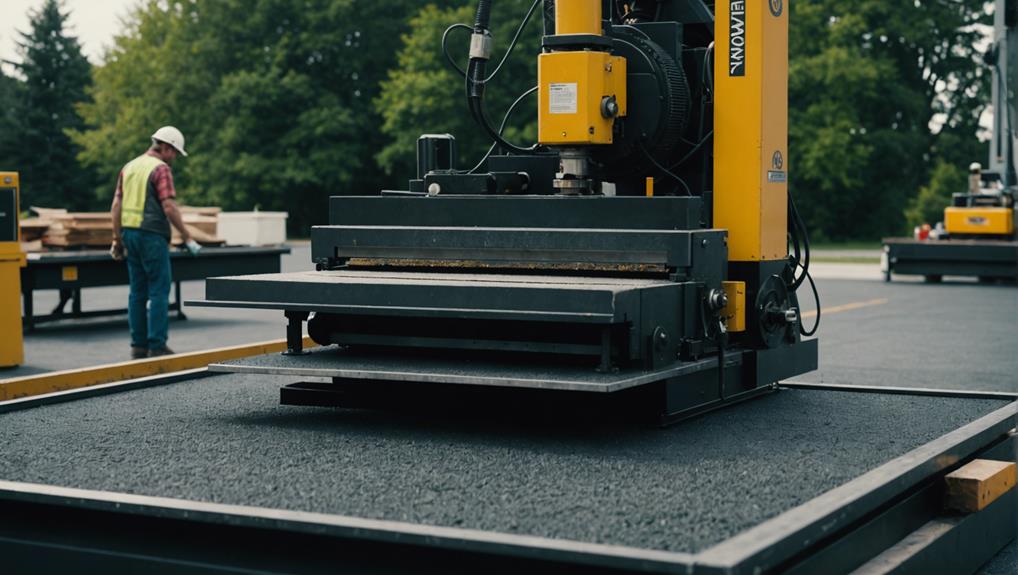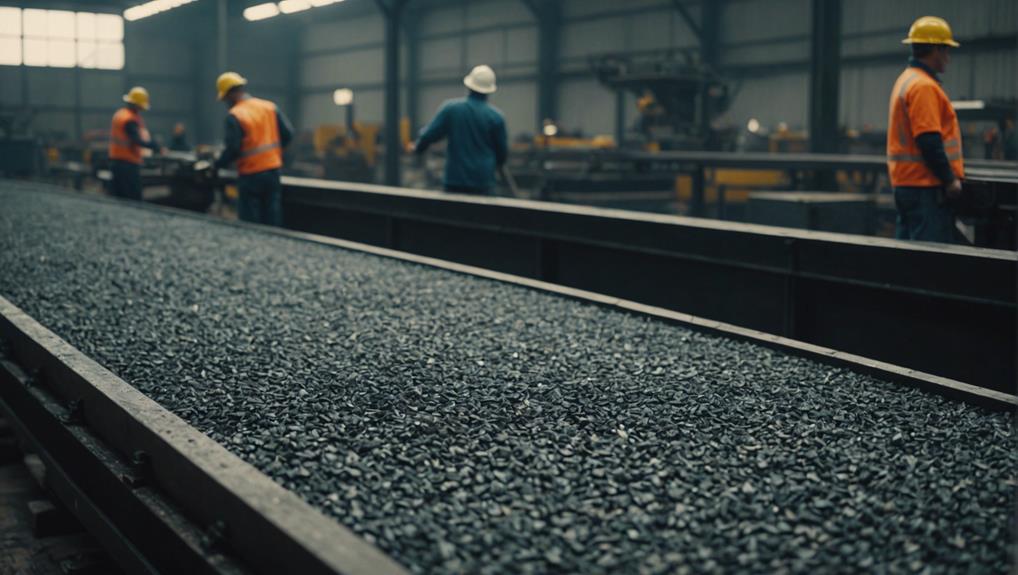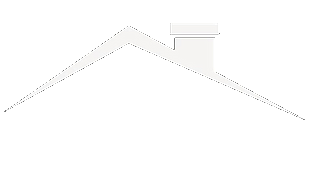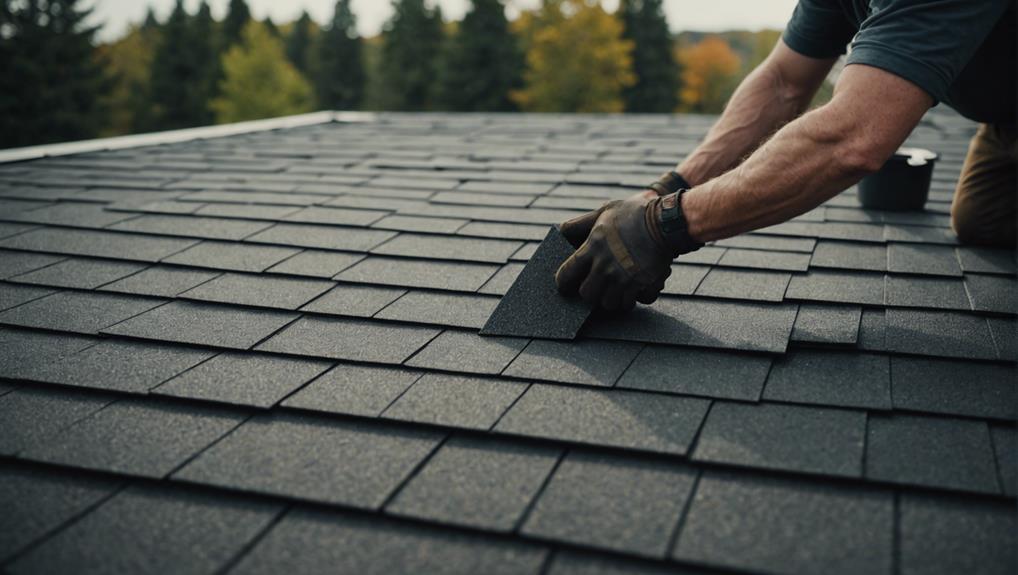If you've ever wondered about the intricate process behind the creation of roofing shingles, you might be surprised at the level of detail and precision involved. From the initial stages of mixing raw materials to the final quality checks, each step plays a vital role in producing a reliable and long-lasting roofing product. But have you ever considered the environmental impact of this manufacturing process? Stay tuned to discover how modern technologies are shaping the future of sustainable roofing shingle production.
Key Takeaways
- Raw materials like bitumen, sand, gravel, and polymers heated to high temperatures for liquefaction and binding.
- Pressing materials into mats, rolling for uniform thickness, and quality checks ensure durability and performance standards met.
- Integration of shingle granules into hot asphalt for weather resistance and durability.
- Cutting machines slice material into 12×36 inch shingles, bundled with various colors and textures for customization.
- Final shingle formation involves precision cutting, offering consistent sizes, colors, and profiles for easy installation.
Shingle Materials Overview
Wood shingles, commonly cut from red cedar or pine trees and treated for fire resistance, are a popular choice for roofing materials. These shingles offer excellent weather resistance and can be enhanced with various colors.
Asphalt shingles, which consist of a fiberglass membrane coated with asphalt and mineral granules, are widely used due to their durability and affordability. The manufacturing process involves the application of chemical preservatives to enhance fire resistance and prolong the lifespan of the shingles. Different types of asphalt shingles are available, including strip style (3-tab) and dimensional laminated styles, providing versatility in design and performance.
While aluminum shingles are known for their durability, they tend to be more expensive compared to other shingle materials. Luxury shingles are also an option, offering premium protection and a realistic appearance that enhances curb appeal.
Heating and Mixing Process
During the heating and mixing process involved in making roofing shingles, various raw materials such as bitumen, sand grains, gravel, and synthetic polymers are combined at high temperatures to form a viscous mixture for the shingle base.
The heating of these components is essential as it allows for the bitumen to liquefy and bind the other materials together, ensuring a strong and durable final product. The sand grains and gravel provide structure and strength to the mixture, while the synthetic polymers enhance the shingles' performance and longevity.
Once the materials are thoroughly mixed and heated, they're laid out into large mats and pressed using rollers to achieve uniform thickness and distribution. Quality control checks are performed throughout this process to guarantee that the shingles meet industry standards for durability and performance.
This meticulous attention to detail during the heating and mixing stage is vital in producing high-quality roofing shingles that can withstand various weather conditions.
Pressing and Cutting Stage

In the pressing and cutting stage of roofing shingle production, shingle granules are integrated into hot asphalt to enhance durability and weather resistance before the cutting machines slice the material into individual shingles. These shingle granules, comparable to tiny pebbles or stones, become embedded in the hot asphalt, providing added strength against harsh weather conditions. The cutting machines then precisely slice the shingle material into individual shingles, typically in the common size of 12×36 inches. Once cut, the shingles are ready for packaging.
After the cutting process, the shingles are carefully packaged into bundles. Various colors, textures, profiles, and patterns are available for selection. To facilitate easy installation and prevent sticking during packaging, an additional layering process is applied to the shingle material. This layering guarantees that roofing professionals can easily separate the shingles during installation. Manufacturers also provide guidance on the quantity of bundles needed per square foot, aiding roofers in estimating and planning for the installation process effectively.
Quality Control Measures
To guarantee the highest standards of quality in roofing shingle production, meticulous quality control measures are implemented throughout the manufacturing process. Quality control starts with the selection of raw materials and continues until the final inspection of finished shingles. Various aspects are closely monitored to ensure excellent quality, including coating thickness, granule application, and adhesive strength. The fiberglass and organic mats are rigorously tested for strength, tear resistance, and uniformity to meet quality standards. Additionally, the asphalt coating thickness and mineral coating distribution are key checkpoints in the quality control process. Third-party testing labs play a pivotal role in verifying that the roofing shingles comply with industry standards such as UL and ASTM specifications.
| Quality Control Measures | Description |
|---|---|
| Raw Materials | Selection of high-quality materials |
| Coating Thickness | Monitoring the thickness of the coatings |
| Granule Application | Ensuring proper application of granules |
| Adhesive Strength | Testing the strength of adhesives |
Final Shingle Formation

In the final stage of shingle production, the cooled shingle material undergoes precision cutting to form individual shingles of standard sizes, typically 12×36 inches, facilitating their packaging for distribution.
These shingles come in various colors, textures, profiles, and patterns, allowing for customization based on aesthetic preferences and architectural requirements.
Once cut, the shingles are bundled together to streamline transportation and simplify the installation process on roofs.
Quality control measures are implemented during the final shingle formation to guarantee consistency in the product packaging, ensuring that each shingle meets the required standards before reaching the end consumer.
Frequently Asked Questions
How Is a Roof Shingle Made?
When making roof shingles, a meticulous process of layering materials like fiberglass or organic fibers with hot asphalt guarantees durability. The addition of shingle granules enhances weather resistance and algae protection, offering various colors and textures for easy installation.
What Are the Raw Materials for Shingles?
When making shingles, raw materials like bitumen, sand grains, gravel, and synthetic polymers are heated and pressed into mats, then cut into squares. Quality checks are crucial to guarantee shingle durability, weather resistance, and eco-friendliness.
What Are the Ingredients in Roof Shingles?
When crafting shingles, manufacturers blend asphalt, fiberglass, and ceramic-coated granules to fortify against elements. This mix guarantees strength, durability, and UV protection. The resulting shingles offer long-lasting weather resistance and an array of color options for your roof.
What Is the Process of Asphalt Shingles?
To understand the manufacturing process of asphalt shingles, examine the intricate steps involved in creating these weather-resistant materials. Quality control guarantees durability, while recycling options and environmental impact play a vital role in sustainable practices.
Conclusion
Now that you understand the intricate process of how roofing shingles are made, have you ever considered the level of precision and expertise required to guarantee each shingle meets industry standards for durability and performance?
From the meticulous heating and mixing of raw materials to the final quality control measures, the manufacturing of roofing shingles is a complex yet essential process in providing reliable protection for homes and buildings.



